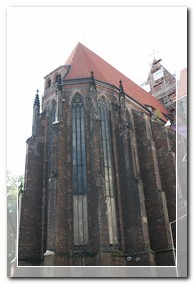


 ituated near the market square and put backwards to the Swidnicka street the Church under the call of saint Stanislas, saint Dorothy and saint Wenceslas was financed in 1350 to commemorate the agreement about the rights to Silesia established between Kazimierz the Great and Charles IV. Three patrons of the church symbolized three countries, which history was connected to Wroclaw: Czechs, Poles and German settlers. Till the year 1530 the church belonged to Augustans–eremites. Franciscans took it over four years later, however because reformation was growing in strength they happened to be insufficient and they had to pass it to the municipal council in 1534. Since 1561 till the return of the complex of monastic buildings, it was used as a store-house from. After the dissolution of the monastery in 1810, monastic buildings contained since 1817 a prison and then they were taken apart. The land after it was purchased for terrific on those times sum of 600 thousand marks by a Wroclaw's banker, Wallenberg Pachaly, and the architect Karl Grossem, who build a trading house and a luxurious hotel. Only the church survived, in which a new entry was made in the western elevation and which was not destroyed despite the terrific prices of allotments in this region. Such a huge accumulation of churches in Wroclaw often surprises the tourists, as also the fact, that despite so many wars and such a dynamic development of the city many of the old temples lasted out to our times. The reason is the reluctance of Wroclaw's citizens to destroying temples — rebuilding or building newer churches on it's place was always possible, however it's demolition and giving the sacrificed ground for different purposes would have brought bad luck, this is why a once made church lasted so long on how it's technical state allowed to and then it was replaced with a new temple.
ituated near the market square and put backwards to the Swidnicka street the Church under the call of saint Stanislas, saint Dorothy and saint Wenceslas was financed in 1350 to commemorate the agreement about the rights to Silesia established between Kazimierz the Great and Charles IV. Three patrons of the church symbolized three countries, which history was connected to Wroclaw: Czechs, Poles and German settlers. Till the year 1530 the church belonged to Augustans–eremites. Franciscans took it over four years later, however because reformation was growing in strength they happened to be insufficient and they had to pass it to the municipal council in 1534. Since 1561 till the return of the complex of monastic buildings, it was used as a store-house from. After the dissolution of the monastery in 1810, monastic buildings contained since 1817 a prison and then they were taken apart. The land after it was purchased for terrific on those times sum of 600 thousand marks by a Wroclaw's banker, Wallenberg Pachaly, and the architect Karl Grossem, who build a trading house and a luxurious hotel. Only the church survived, in which a new entry was made in the western elevation and which was not destroyed despite the terrific prices of allotments in this region. Such a huge accumulation of churches in Wroclaw often surprises the tourists, as also the fact, that despite so many wars and such a dynamic development of the city many of the old temples lasted out to our times. The reason is the reluctance of Wroclaw's citizens to destroying temples — rebuilding or building newer churches on it's place was always possible, however it's demolition and giving the sacrificed ground for different purposes would have brought bad luck, this is why a once made church lasted so long on how it's technical state allowed to and then it was replaced with a new temple.






